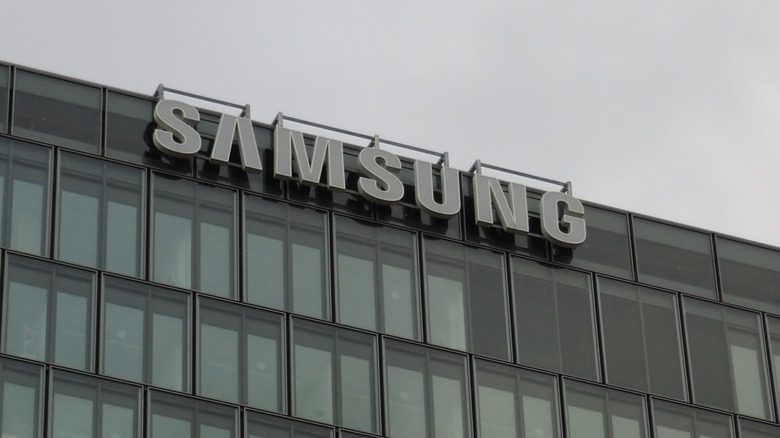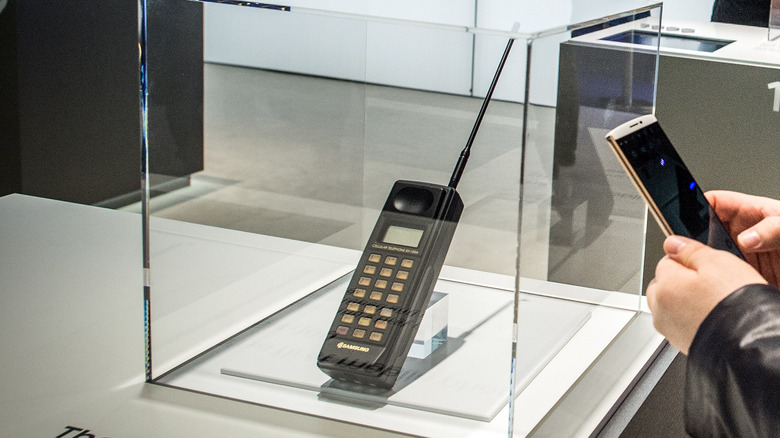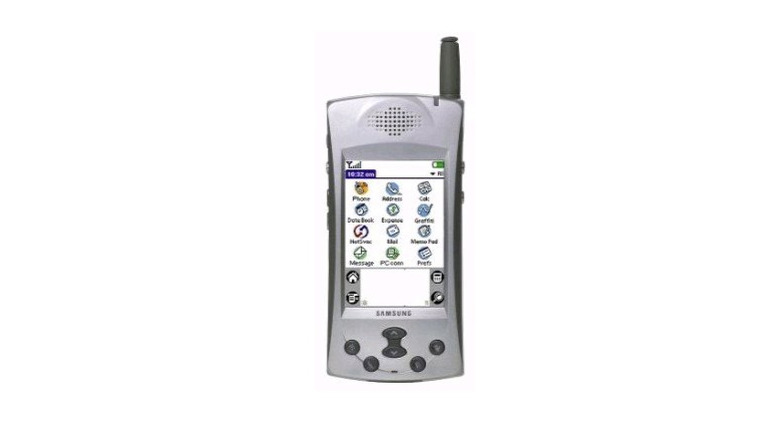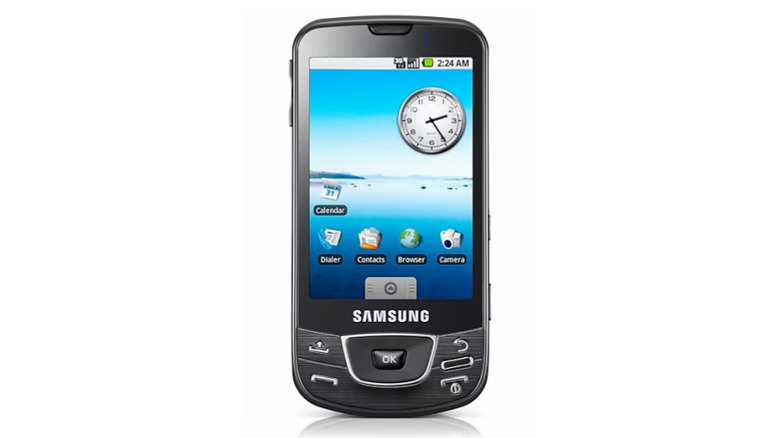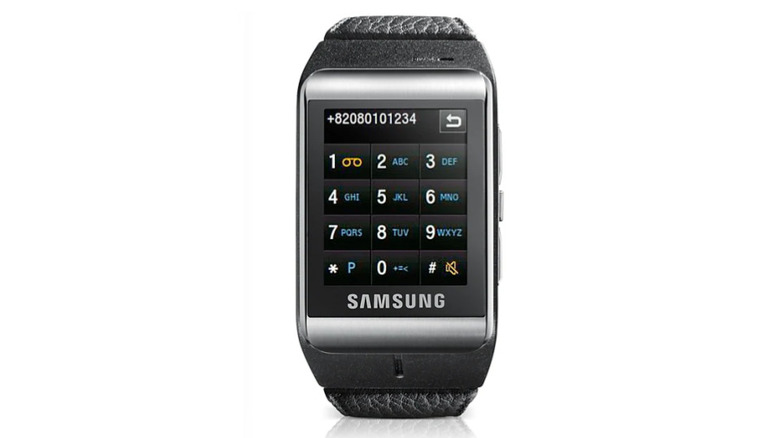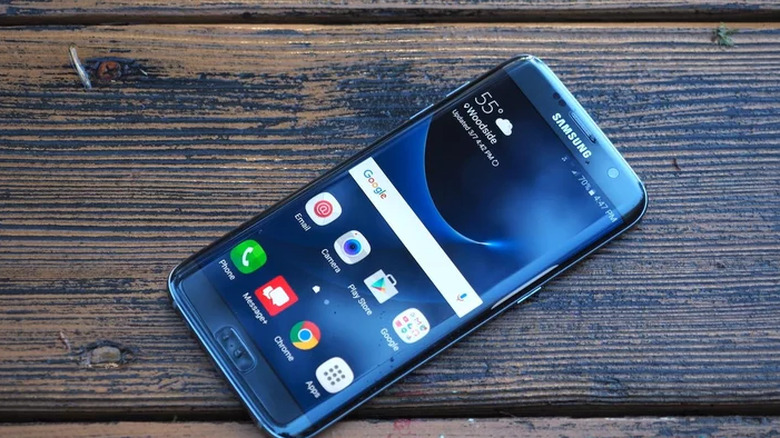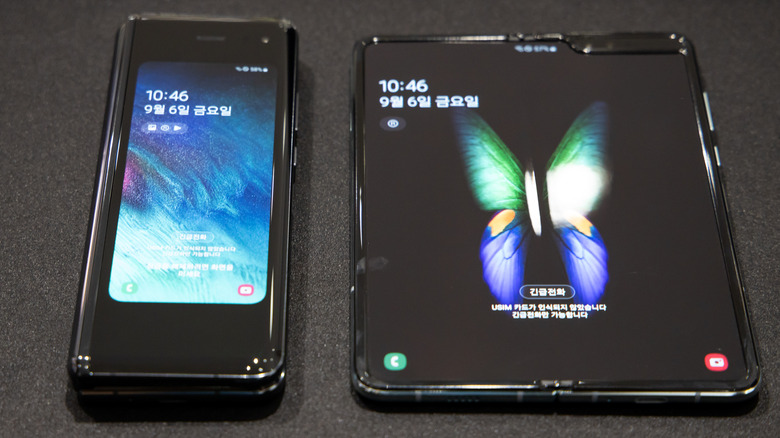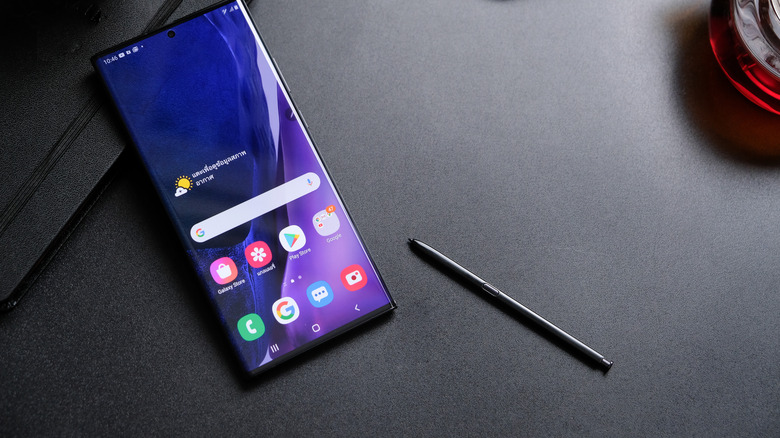10 Of The Biggest Moments In Samsung Mobile's History
In the modern mobile landscape, there are very few names that get to sit at the top of the mountain. While Apple may reign supreme in the United States with the iPhone lineup, Samsung commands a considerable presence both stateside and abroad. For far longer than Apple has, the South Korean tech giant has been making mobile devices. Moreover, their products are much more known for being on the edge of innovation, though not always for the best. The history of Samsung Mobile's presence in the industry has many ups and downs, but undoubtedly many huge moments.
From being on the absolute cutting edge of smartwatch and smartphone technology to having some of the biggest controversies in the realm of smartphones, Samsung's history is rich with key moments that were impactful for both the company and the wider industry. Amidst the long history of Samsung Mobile, some moments stand as the biggest moments in their history, for better or worse.
1988: Samsung's first mobile phone
Although Samsung may be much more well known now for the Galaxy lineup of smartphones, they made a lot of mobile phones before the rise of the smartphone. All the way back in 1988, Samsung released the SH-100, their first foray into the world of mobile phones. As the tech landscape was in the throes of transformation, this device marked Samsung's entry into a realm that would come to define its future identity.
The Samsung SH-100 marked the beginning of Samsung's long-running history of making cell phones, but it was also the beginning of cell phone manufacturing in South Korea. The SH-100 was the first cell phone ever made in South Korea. Prior to the release of the SH-100, Samsung had made the SC-1000. The SC-1000 was itself a cell phone; however, it wasn't quite mobile. Rather, it was made for use in cars.
As a cellphone made in the 1980s, the SH-100 is bulky. It also has a large antenna. While the device itself is very clunky by the standards of phones today, the phone stands as a standard entry into the field that existed at the time. However, the SH-100 was hardly a hit. The success of phones today is generally measured by sales. The sales of most flagship phones today usually see figures in the millions. The Samsung SH-100 sold around a paltry 2000 units. Not exactly a smash hit, by any standard. Nevertheless, the phone was the first step to what would become a large part of Samsung's future.
2001: Samsung's first smartphone
When you think of Samsung's smartphone, it's easy to immediately think of the Galaxy lineup. For a very long time in the American phone market, it was always a game of Apple, Samsung, and everybody else. However, the Galaxy isn't all Samsung has ever made in the realm of smartphones.
While other outings like the Windows-based Samsung Focus exist, Samsung actually didn't get into the smartphone game with Windows — or Android, for that matter. Long before the days of the iPhone, in 2001, the tech giant unveiled its first smartphone, the Samsung SPH-I300. The smartphone, powered by the Palm OS, was an early touchstone on the long road of smartphone history. At first glance, the SPH-I300 presented a familiar form factor, resembling other brick-shaped phones on the market. However, the integration of a touchscreen, a feature that was a little too ahead of its time, marked the device's biggest point of difference.
Naturally, the touchscreen wasn't great. It was 2001, after all. The most tellingly mediocre spec of the SPH-I300's touchscreen is the fact that it is resistive rather than capacitive. Capacitive touch screens are what exist on almost every modern phone in use today. Resistive, on the other hand, is more akin to the touch screens found on retail POS systems.
While the SPH-I300 may seem rudimentary by today's standards, its significance in 2001 cannot be overstated. However, as with any trailblazing technology, the SPH-I300 faced its share of challenges. The smartphone market was still in its infancy, and consumer expectations were evolving rapidly. Samsung's venture into the smartphone realm was a testament to its willingness to try new things in the market.
2009: Samsung begins using Android
In the year 2009, Samsung embraced the Android operating system, a pivotal decision that laid the foundation for its ongoing central role in the smartphone market. The Samsung Galaxy I7500 marked the beginning of both Samsung's relationship with Android, and the Galaxy lineup of phones.
Samsung's maiden voyage into the Android ecosystem provided users with a versatile and user-friendly experience. More importantly, it provided an alternative to the rapidly growing popularity of the iPhone. The device boasted a 3.2-inch AMOLED display, a technological marvel at the time, offering users a vibrant and immersive visual experience.
The integration of Android introduced users to a new era of app-centric functionality. The Google Play Store, then known as the Android Market, provided a gateway to a myriad of applications, transforming smartphones from communication tools into versatile pocket computers. The Galaxy I7500's foray into Android marked the beginning of Samsung's journey toward customization and optimization. Samsung's TouchWiz UI, layered atop Android, introduced a level of personalization that would become a hallmark of its future devices.
While the Galaxy I7500 marked a significant shift in Samsung's mobile strategy, it was also a learning curve. Early Android iterations had their quirks; later models would aim to refine the user experience. The Galaxy I7500 was a stepping stone, but a hugely important one within the history of Samsung's mobile devices.
2009: Samsung's first smartwatch
In 2013, Samsung leaped into the realm of wearable technology with the introduction of the Samsung Galaxy Gear, marking the company's first iteration of their ongoing lineup of smartwatches, which has since become known as the Galaxy Watch. However, it wasn't their first smartwatch. Before the Samsung Galaxy Gear, there was the Samsung S9110 in 2009.
On the surface, the watch looked much the same as the original Galaxy Gear, but it was significantly less advanced. At the time, the device was known as a "watchphone." However, with Bluetooth connectivity, Outlook syncing, built-in mobile calling available, and voice controls, there's an argument to be made that this was one of the original smartwatches in the sense of how the devices are thought of today.
While the S9110 may not have boasted the plethora of apps and sensors that characterize contemporary smartwatches, its release was a crucial stepping stone in the evolution of wearables. Samsung's first step into the smartwatch arena set the industry at large to exploring smartwatches on a larger scale. After all, the S9110 was released six years before the first-ever Apple Watch. It would be another four years until the launch of the first Galaxy Gear. If ever Samsung released a product that was just barely ahead of its time, it was with the release of the S9110.
Interestingly, the S9110 wasn't Samsung's first watchphone. As a matter of fact, their first watchphone was released ten years before the S9110. Samsung's first watchphone was the SPH-WP10, which was a far less smart iteration of the watchphone. The device looked like a watch you'd see in a James Bond movie, equipped with a large phone piece poking off the side of the watch.
2012: Samsung invents the phablet
There was a time when giant phone screens were laughed at. And believe it or not, a "laughably large phone screen" once included a 5.3-inch display. That was the screen size of the original Samsung Galaxy Note, the first "phablet." The Galaxy Note can today be seen as tremendously prescient. In a market that had once been obsessed with releasing increasingly more compact phones, Samsung was the first major manufacturer to take smartphones the exact opposite way.
The Galaxy Note's display wasn't just about size; it was a canvas for innovation. Samsung's Super AMOLED technology was just getting better as time went on, and looked great on the Note. The S Pen, an accompanying stylus, added functionality to the conventional touchscreen interface. With the S Pen, users could sketch, take notes, and navigate with unprecedented precision, leveraging the smartphone into a tool for productivity.
The Galaxy Note received its fair share of skepticism; critics questioned the viability of a device straddling two form factors. However, consumer response shattered these doubts. The Galaxy Note found a niche, resonating with users who sought a device that could handle the demands of both work and play. Samsung had not just invented a device; it had ignited a cultural shift that would eventually lead to much larger phones.
As the Galaxy Note gained traction, its impact reverberated across the industry. Competitors soon recognized the potential of larger form factors and stylus-based interaction. The phablet category, once met with skepticism, became a cornerstone of the smartphone market. While the release of the Galaxy Note is an undeniably large point in Samsung's history, it is also a huge point in the history of smartphones at large.
2012: Samsung releases their best-selling smartphone to date
2012 wasn't just the year of the Note for Samsung, as it also marked the biggest smartphone release in the company's history. In 2012, the Samsung Galaxy S III was released, a smartphone that not only captured the essence of cutting-edge technology but also went on to become the best-selling smartphone in the company's history. At the core of the Galaxy S III's success was refinement.
The smartphone held a 4.8-inch Super AMOLED display, not so different from its predecessors, but the phone came in a much different shape than the original Galaxy and Galaxy S II. The Galaxy S III was rounded rather than the large rectangle shape that was being taken over by the Galaxy Note. The shape was often compared to a pebble, due to Samsung's seeming obsession with pebbles at the time with the Galaxy S III coming in "Pebble Blue," in addition to the release of the Samsung S Pebble the same year.
The marketing and release strategy for the Galaxy S III saw Samsung position the device as not just a gadget but an integral part of users' daily lives. The "Designed for Humans, Inspired by Nature" tagline resonated, emphasizing a human-centric approach to technology. The global launch events and marketing campaigns created a buzz that propelled the Galaxy S III into the spotlight.
The popularity of the Galaxy S III can best be summed up by one key stat: In Q3 of 2012, it outsold the iPhone 4S, and for that matter, every other smartphone in the world. The device now sits comfortably as Samsung's best-selling smartphone. For a device that really put Samsung on the map for the average consumer, the Galaxy S III is truly the only real option.
2014: Samsung gets an edge
Having already changed the game in terms of smartphone screen size, it was time for Samsung to explore a third dimension with the Samsung Galaxy Note Edge. The Galaxy Note Edge's most distinctive feature was its curved display that sloped down the right side of the device, creating an "edge" that housed a range of interactive panels and shortcuts. Users could customize the edge panels to provide quick access to apps, notifications, and other information without obstructing the main screen.
After the release of the Galaxy Note Edge, Samsung went on to release the Galaxy S6 Edge and the Galaxy S7 Edge. Both devices took the curved screen, but the Edge moniker never ended up making its way back to the Galaxy Note lineup. The S7 Edge ended up being the more fully realized of the two Galaxy S Edge releases.
Samsung's foray into curved displays opened a Pandora's box in the realm of smartphones. The release of the Galaxy Note Edge and the subsequent Galaxy S iterations kicked off a curved edge trend that saw other phone manufacturers seeking to take the curved idea to its absolute limits. The problem was that the Galaxy Note Edge and its successors weren't exactly known for being ergonomic paradises. As other companies began to release their attempts at the curved display, it was becoming clear that ergonomics wasn't exactly a top priority.
The S6 Edge also had some durability concerns insofar as having a delicate screen, as well as getting caught up in the whirlwind of Bendgate. Testing showed that the Galaxy S6 Edge did bend very easily, much like the iPhone 6 Plus.
2016: The Samsung Galaxy Note 7 release and recall
Not every big moment is as big as it is for a good reason. There's no better example of that than the exploding phone debacle Samsung had on its hands with the release of the Samsung Galaxy Note 7. The Galaxy Note 7, as most will know, had a bit of a heating issue. Said issue resulted in many phones catching fire and exploding. Video of instances of the Galaxy Note 7's issue went viral online, and the company soon issued an official recall of the Galaxy Note 7.
The Galaxy Note 7 was intended to be a triumph, boasting an array of advanced features, including a curved display, iris recognition, and enhanced S Pen functionality. In absolute fairness, the device received very positive reviews upon its release, before knowledge of the phone's issue was fully known.
The crisis had a profound impact on Samsung, causing reputational damage and financial setbacks. Investigations revealed that the issue stemmed from a flaw in the battery design, leading to overheating and, in some cases, combustion. The recall of the phone was a significant undertaking, involving the coordination of global efforts to collect millions of devices. Eventually, Samsung went as far as bricking every remaining Galaxy Note 7 in the US that wasn't collected.
The Galaxy Note 7 incident had broader implications for the industry, sparking conversations about the race for innovation and the need for rigorous testing in the fast-paced world of technology. In the aftermath of the Galaxy Note 7 controversy, Samsung lost a significant amount of consumer trust. The incident prompted a renewed commitment to quality assurance, leading to the company promising more robust testing for future releases.
2019: Samsung releases their first foldable
After pioneering the phablet seven years prior, Samsung once again threw its hat into the ring for the next big step in smartphone innovation: foldables. In 2019, the Samsung Galaxy Fold was released. The Galaxy Fold was a massive departure from conventional smartphone design, featuring a foldable 7.3-inch Infinity Flex Display that could seamlessly transition from a compact phone to a tablet.
When the Galaxy Fold launched, that's when things went off the rails. In the early stages, some review units experienced issues with the display, leading to concerns about the device's durability. There were persistent issues involving reviewers peeling off a screen protector that came on the inner display that wasn't meant to be removed under any circumstances. Unfortunately, Samsung didn't really label the screen protector as something that shouldn't be removed.
The company postponed the official release and made necessary design adjustments to address concerns. Upon its re-release, the Galaxy Fold was met with renewed excitement and positive reviews. Of course, it still had its issues. One major issue was that the outside display was abysmal. It was oddly small, and definitely not something many users would find themselves using over the inner display.
The Galaxy Fold may be the weakest foldable Samsung has ever released, but it marked the beginning of a new era. The Galaxy Fold paved the way for subsequent foldable devices, including the Galaxy Z Flip lineup and the Galaxy Z Fold lineup, each version building upon the lessons learned and the feedback received from the Galaxy Fold.
2020: Samsung releases their final Note phone
In 2020, Samsung bid farewell to an iconic series with the release of the Samsung Galaxy Note 20, marking the end of the Galaxy Note era. The series had become synonymous with productivity, innovation, and the S Pen stylus, creating a legacy that left an indelible mark on the smartphone landscape. While the large phablet wouldn't entirely disappear from the Samsung lineup, with both the Galaxy S Ultra line and Galaxy Z Fold line taking its place, the end of the Galaxy Note lineup still marked a significant shift for Samsung.
The Galaxy Note 20 arrived at a juncture where the smartphone market was evolving, with larger displays and enhanced capabilities becoming standard across various device lineups. Where the large screen of the original Galaxy Note had been mocked, it was dwarfed by the average screen size of many modern flagships. As Samsung's Note release for 2020, the Note 20 continued the tradition of offering a powerful and feature-rich experience, catering to users who demanded top-tier performance and productivity.
The decision to conclude the Galaxy Note series was met with mixed sentiments. Enthusiasts mourned the end of an era that had spanned a decade, while others eagerly anticipated how Samsung would integrate the beloved features of the Note into its evolving lineup. The Galaxy Note was dead, but it wasn't the end of the driving design philosophy behind it.
The Galaxy Note series, with its emphasis on productivity and innovation, will forever hold a special place in the hearts of tech enthusiasts. Even though it is now a product of the past, its lasting legacy on Samsung's lineup and the wider world of smartphones is still seen to this day.
